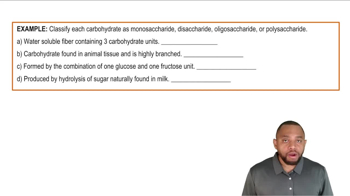Melezitose, a carbohydrate secreted by insects, has the following Haworth structure:
c. Is melezitose a reducing sugar?
 Verified step by step guidance
Verified step by step guidance Verified video answer for a similar problem:
Verified video answer for a similar problem:


 1:24m
1:24mMaster Polysaccharides Example 1 with a bite sized video explanation from Jules
Start learning